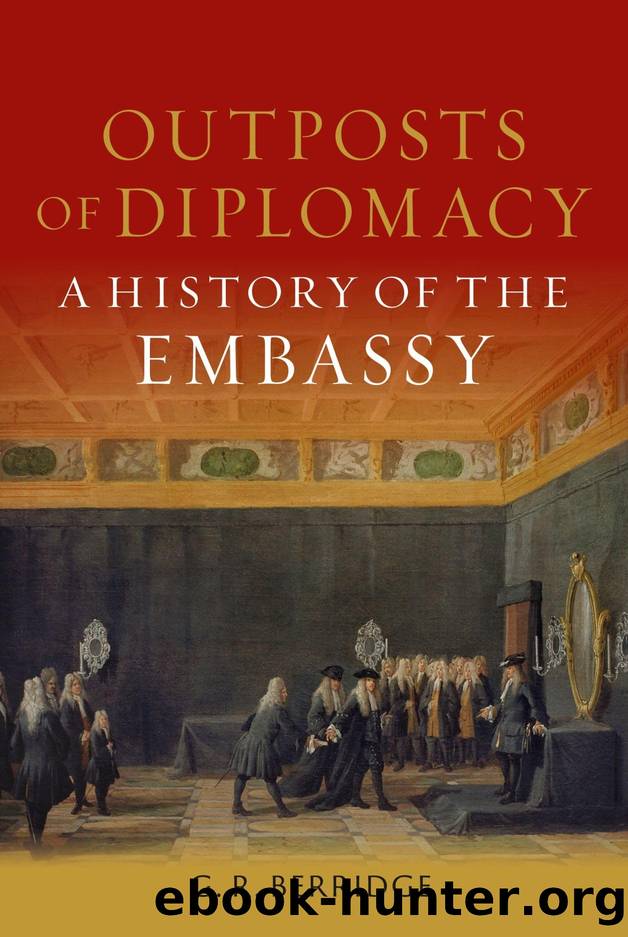Outposts of Diplomacy: A History of the Embassy by G. R. Berridge

Author:G. R. Berridge [Berridge, G. R.]
Language: eng
Format: epub
Tags: History, General, Political Science, International Relations, Diplomacy
ISBN: 9781789148497
Google: 3Av6EAAAQBAJ
Amazon: 1789148499
Publisher: Reaktion Books
Published: 2024-05-23T00:00:00+00:00
Alexandr Sergeyevich Griboyedov (1795â1829), Russian minister murdered in Tehran during an attack on his legation by a fanatical mob.
London turned out to be not so obtuse as Rawlinson supposed. In April 1860 it swiftly replaced him with Charles Alison, who had a somewhat unconventional manner and an unconventional background: he was believed to be the son of the paymaster of an English regiment at Malta, had no formal education and had begun his working life in the service of the British consul-general in Albania, a distant relative. However, he was highly intelligent, multilingual, hardworking, modest and amiable. He also had a large personality and plenty of confidence. Austen Henry Layard, the discoverer of Nineveh, whose acquaintance and experience were not exactly narrow, described him in his memoirs as âperhaps the man most highly endowed by nature that I have ever knownâ. It is hardly surprising, therefore, that, having joined the British Embassy at Constantinople as a paid attaché in 1839, Alison became a man who was not only liked and respected but also the backbone of the mission under Stratford Canning for the next twenty years. First he had been chief interpreter, then in 1844 Oriental attaché, secretary of embassy in 1857, on special service at least seven times, and chargé dâaffaires twice.
A little under three years after arriving in Tehran, in February 1863 Alison married in Paris Eliza, the widow of the Ottoman sultanâs banker, Theodore Baltazzi, reputed to be the richest man in Constantinople and with whom she had already had ten children; but she was soon seriously ill, died in Cairo in December and was therefore never able to join her new husband in Tehran. Alison later acquired an Armenian partner, Victoria, which added another black mark to his lowly origins in the eyes of former India Office man Edward Eastwick, his secretary of legation at Tehran. Eastwick was a sanctimonious snob, considered anyone not âa true Englishmanâ to be a second-class citizen or worse, and in 1862 had already written poisonous letters to the Foreign Office about his chief. To its credit, headquarters got rid of Eastwick rather than Alison, and the latter ran the mission in Tehran very ably until his death in office in 1872. It was also Alison who persuaded his government to build a new legation on a new site and then oversaw the project.
By the mid-1860s the British Legationâs building in Tehran, which fifty years earlier had been a glittering spectacle, was sadly dilapidated and hemmed in by civilian housing. Its site was also an awkward shape and bisected by a public street. Moreover, Alison warned the Foreign Office, the Russians were building a large new palace. In 1868, with the cityâs old walls being knocked down to allow its expansion, Alison was able to find a suitable 6.5-hectare (16 ac) rectangular site on what was to be Ferdowsi Avenue. On this he helped to drive forward the building of a self-contained compound behind a high boundary wall, which, as we shall see, was already becoming a feature of mission building elsewhere in the non-European world.
Download
This site does not store any files on its server. We only index and link to content provided by other sites. Please contact the content providers to delete copyright contents if any and email us, we'll remove relevant links or contents immediately.
| Bahrain | Egypt |
| Iran | Iraq |
| Israel & Palestine | Jordan |
| Kuwait | Lebanon |
| Oman | Qatar |
| Saudi Arabia | Syria |
| Turkey | United Arab Emirates |
| Yemen |
Empire of the Sikhs by Patwant Singh(23025)
The Wind in My Hair by Masih Alinejad(5060)
Rise and Kill First by Ronen Bergman(4741)
The Templars by Dan Jones(4659)
The Rape of Nanking by Iris Chang(4170)
12 Strong by Doug Stanton(3528)
Blood and Sand by Alex Von Tunzelmann(3168)
Babylon's Ark by Lawrence Anthony(2650)
The History of Jihad: From Muhammad to ISIS by Spencer Robert(2602)
No Room for Small Dreams by Shimon Peres(2346)
Inside the Middle East by Avi Melamed(2331)
The Turkish Psychedelic Explosion by Daniel Spicer(2331)
Gideon's Spies: The Secret History of the Mossad by Gordon Thomas(2322)
Arabs by Eugene Rogan(2283)
The First Muslim The Story of Muhammad by Lesley Hazleton(2251)
Come, Tell Me How You Live by Mallowan Agatha Christie(2230)
Bus on Jaffa Road by Mike Kelly(2125)
Kabul 1841-42: Battle Story by Edmund Yorke(2006)
1453 by Roger Crowley(2001)
